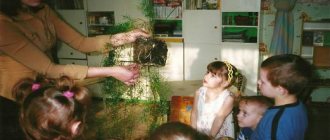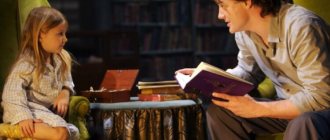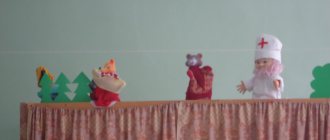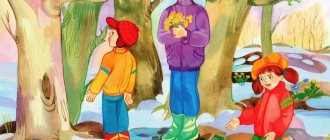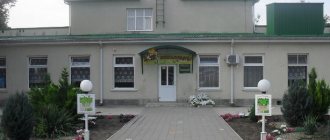Organization of a walk. Themed walks with preschoolers. article on the topic
Organization of a walk. Themed walks with preschoolers.
In the educational process, an important element in the daily routine is walking with children. The main task of the teacher when conducting walks is to provide active, meaningful, varied and interesting activities for children.
Traditionally, a walk includes such components as organizing children’s observations of natural phenomena (flora and fauna, inanimate nature); various games; work activity; sports exercises and independent activities of children according to their choice and interests. In this case, it is necessary to provide for a uniform alternation of calm and motor activity, distribution of physical activity during the entire walk.
To ensure that walks are varied and interesting for children, educators plan their content daily, including both the educational component and the children’s independent activities. Independent and joint activities with peers presuppose the availability of a variety of playing materials and equipment, the creation of various flexible subject-based play tools in the kindergarten area.
When planning a walk, the teacher must take into account many factors: weather conditions, the age of the children and their cognitive interests, available material, the topic of the previous lesson. It is necessary to provide for the possibility of a healing effect not only physically, but also mentally. For a child’s body, a properly organized walk can be the most accessible means of hardening.
The basic requirements that must be observed when organizing walks are defined in the relevant regulatory documents.
The joint activity of an adult with children during a walk is especially pronounced, since it is here that the child closely communicates with the teacher in all types of activities.
For a child, the educational process makes sense if it is built in the logic of activity. Therefore, the educational component of a walk is always connected with any type of children’s activity (play, communication, work, motor, cognitive-research, musical-art, productive) without its strict regulation.
It is clear that the leading play activity, through which the child learns about the world and organically develops, has a special role during a walk. Game forms of education can be in an individual, subgroup or frontal form of organizing work with students. Motor activity during a walk is combined with play, but at the same time the teacher is obliged to regulate the load by monitoring the condition of the children.
Modern requirements for updating the educational process suggest making walks as diverse as possible in content and organization.
In the methodological literature and individual regulatory documents, one can find confirmation that in addition to the traditional structure of walks with children that have developed over the years, thematic walks can be held, built on the principle of dominance of the type of children's activity or that are a continuation of the theme of the day in the educational process.
The authors of the guide “Themed Walks in Kindergarten” offer five types of themed walks:
walks and hikes;
entertaining walks with a character;
walk-events;
sports walks;
walks are labor actions.
Hiking is an organized type of activity, during which health-improving tasks are solved, motor skills and physical qualities of children are improved, their cognitive needs are satisfied, and love and aesthetic attitude towards nature are fostered. They should be carried out with children of older preschool age. The optimal number of such walks is 2-3 per year. We believe that if these walks are carried out frequently, they will lose their attractiveness and children’s interest in them will decrease.
Entertaining walks with the character are aimed at emotional and psychological relief for children, creating a positive emotional background, and satisfying children’s needs for physical activity. The forms of their organization can be diverse and variable, since they depend not only on the goals and objectives set, but also on the thematic focus and semantic richness.
Walking with a character is good for motivating children for a certain type of activity; the character helps to interest all the children in the group, attract them to joint play activities, observation, and work.
Walk-events are dedicated to a specific theme (Cosmonautics Day, Defender of the Fatherland Day, Victory Day, City Day, Knowledge Day, etc.) or an event that occurred in kindergarten (a new play complex was brought and installed, sports equipment was updated, sand was updated in the sandboxes, etc. .).
An event walk (thematic walk) helps the teacher once again draw children’s attention to an important event, clarify their knowledge and perception of a certain topic.
Sports walks are aimed at improving health, preventing fatigue, physical and mental development, and optimizing the physical activity of children. In sports walks, various types of children's activities are united by a sports theme.
When properly organized, these walks have a hardening effect on the body in natural conditions. They help increase the level of physical fitness of preschool children. The emphasis in such walks is on the formation of physical qualities, nurturing interest in sports and a healthy lifestyle.
These walks promote mental, moral, aesthetic education and develop the curiosity of preschoolers.
In walks and labor actions, labor assignments for children predominate, including them in forms of work that are different in organization in accordance with the season and weather conditions.
On walks associated with work activities, children develop an understanding that work in nature is not a game or entertainment, but a serious activity. The teacher brings them to an understanding of the need for such work, fosters a desire to participate in the work of caring for plants, feeding birds, and cleaning the area (raking snow, cleaning the veranda from sand and leaves).
On such walks, children learn to work in a team, together. The result of labor is the result of the joint work of everyone.
Bibliography:
- K.Yu. Belaya, E.A. Karalashvili, L.I. Pavlova and others. Themed walks in kindergarten. M.: Perspective, 2013
Walks in kindergarten. Observations on walks, card indexes, notes
With MAAM you can turn your walk into a mini-trip!
A card index of outdoor games on a walk on the theme “Birds” for older children. Outdoor games on the theme “Birds”
for children 5-6 years old.
1. Outdoor game “Migration of birds”
Purpose of the game: to develop children’s motor activity skills, combining them with cognitive, research, communication, taking into account life safety; develop ingenuity. Progress of the game.
Publication “Summary of the walk “Dandelions” in an early age group of children from 2. » Summary of the walk “Dandelions”. Early age group children from 2 to 3 years old. Purpose of the walk: Examine a dandelion in natural conditions. Compare the flower with the sun, with yellow chickens, with balloons. Find out what color the dandelion is (yellow. Educate.
Consultation “The benefits of walks and excursions for obtaining a variety of experiences that evoke positive emotions” A walk occupies an important place in a child’s life. During a walk, the child learns about the world around him, learns to communicate with peers, and the walk also has health benefits. Parents understand that the child needs to walk as much as possible. However, not everyone knows about.
Summary of the walk “Bird watching in winter”
Purpose of the walk: To continue to observe with children the behavior and habits of birds, to expand and deepen knowledge about birds, to give the concept of wintering birds, to cultivate a desire to take care of wintering birds. Practice the ability to name and compare birds flying to.
Card index of winter walks for children 4–5 years old WALKS WINTER PERIOD (DECEMBER, JANUARY, FEBRUARY) December Walk 1 Observation of tits Goals: • continue to arouse interest in birds; • introduce the tit, its habits, habitat, and appearance features. Progress of observation The painted tit whistles without getting tired.
Recommendation for parents: “Children’s walks in winter”
Remember how, as children, we ourselves loved to splash through puddles, launch boats along spring streams, throw snowballs, sculpt a snow woman, or simply catch snowflakes with our tongues? Every walk improves your health, gives you a lot of positive emotions and new impressions. It's up to you to do it.
Walk “Observing the weather conditions”
Author: Kharitonova Natalya Vladimirovna Purpose: to teach to determine the time of year by characteristic features. Progress of observation Invite the children to see if there is sun or clouds in the sky. Ask what the clouds did (cover the sun, note what the sky is (gloomy, what the weather is (gloomy. They are blowing.
Source
Walking with children in autumn
Collection of natural material
Every parent knows that children love to make appliques and crafts at home. Creativity is familiar to kids who attend kindergarten and school. In any case, you will need natural materials for crafts. This includes beautiful multi-colored leaves, of which there are a great many in autumn.
Collect red, yellow, brown and green leaves of maple, oak, linden and other trees. Acorns, flowers, mushrooms, pine cones and herbs will also come in handy. You can learn how to make crafts and applications from the Internet, from a teacher or primary school teacher. Often natural parts are connected using salt dough, plasticine and glue.
If you are planning to make a panel, then use velvet or other beautiful paper in bright colors as a base. Volumetric crafts require some kind of case; they are often placed in plastic containers, vases and jars.
Boat game
The autumn months are characterized by rain. It's damp outside and you can get a lot of good out of it. Despite the fact that playing in a puddle seems unhygienic to many parents, children get great pleasure from it and a lot of positive emotions. Ships can be purchased in the store.
The best option is several lightweight plastic ships. Then you can wash the toys. Choose boats where you can tie a rope for control. The smallest liners are more convenient, since there are usually few large puddles. Boys and girls will enjoy a walk with boats through puddles.
Flying a kite
All children love kite flying. And when they see this toy floating in the air, they are delighted. Snakes can be purchased at a toy store or made at home using instructions from the Internet. It’s best to go on such a walk with your dad or older brother. Men cope more easily with the task of successfully flying a kite.
In autumn it is usually windy, and this weather is ideal for flying. Go out into an open area, such as a stadium or countryside, and fly a kite. Have fun with your kids.
If the options described above are not suitable, then go on an autumn picnic, invite your child to become a landscape photographer, and watch the changes in nature.
kite in autumn
It’s also a good idea to practice measuring the distance to objects with your steps, watching birds, and playing badminton. To contribute to the cleanliness of your locality and nature in general, it is worth organizing a cleaning on the street near your house.
Walking with children in spring
Spring in the park
When spring comes, children can only feel it while walking. They will enjoy walking in nature and celebrating the signs of spring. For example, it is interesting to measure puddles with a ruler or boots, fill puddles with snow, study trees, widen or block streams, and launch homemade or purchased boats along them.
Talk about how our nature wakes up after winter, track all the changes in the park or outside the city. You can have fun on the rides or just walk down the street with a turntable that will spin in the direction of the wind. And at home after your walk, draw spring.
Studying traffic rules
Walk around the city with your children and make it your goal to explain to them as many aspects of traffic rules as possible. Talk in language accessible to the child, ask questions and tell various little things. Let the children observe how transport moves and how pedestrians behave.
Talk about traffic lights, traffic controllers, zebra crossings and road signs. Don't forget to reinforce the material with home games and drawings.
Active walk
In spring, children want to move and walk more, so it's time to get out your bicycles, balance bikes, roller skates, scooters, etc. Children aged 6-7 years old will enjoy riding a hoverboard. Your task is to drive around the neighborhood until the child gets tired.
On this day you are guaranteed a sea of new emotions, good physical exercise, excellent appetite and a restful sleep for your child. Riding on children's transport promotes the rapid growth of a child, improves his mood and helps him develop harmoniously.
If you don’t have a vehicle or don’t currently have the desire to ride it, then take a ball for a walk and master a few games with this apparatus.
It’s also a good idea to stock up on a set of crayons and draw on the asphalt. Such a walk will remind you that there will be no more snow and cold, summer is approaching. If the child does not know what to draw, offer to circle the shadow cast by a person or any object.
bike ride in spring
Walking with children in winter
Drawing in the snow
A very unexpected and fun activity is to paint on the snow. Try to draw a rainbow. This activity will help you learn colors and hone your artistic skills. Drawing in the snow is more fun than you think.
Skiing from the mountains
Make it your goal to explore as many snowy mountains in the area as possible, armed with your ski gear. Then you will be surprised how enthusiastically your child will share his impressions of different slides. Perhaps sliding down a slide seems like a frivolous activity to you, but for a child it is a real winter adventure.
Snowmen
The best winter fun is making a big snowman in a group. The child will be happy to roll snow globes and decorate the sculpture. While working, distribute responsibilities and actively discuss what you are doing. This communication is very productive for the child, it has a positive effect on his development and emotional state, and brings him closer to his parent.
Go ahead and build a whole family of snowmen. Or make snow cakes using molds. Color the cakes with paints. When you get tired of making snowmen, make a target and throw snow balls at it, your child will also love it.
building a snowman in winter

